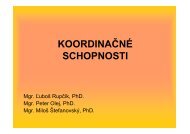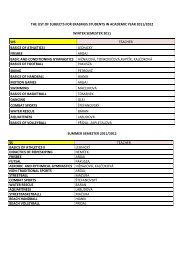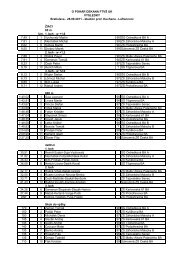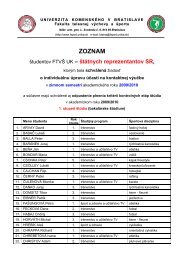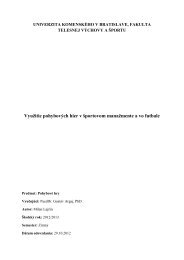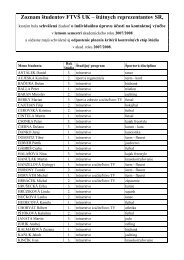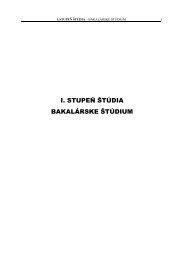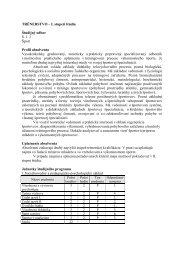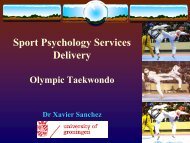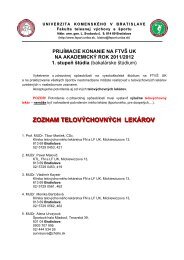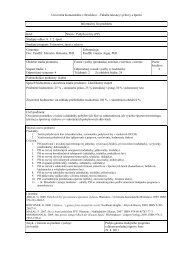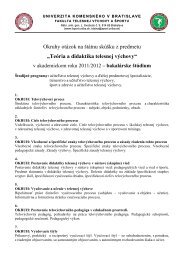acta facultatis educationis physicae universitatis comenianae
acta facultatis educationis physicae universitatis comenianae
acta facultatis educationis physicae universitatis comenianae
You also want an ePaper? Increase the reach of your titles
YUMPU automatically turns print PDFs into web optimized ePapers that Google loves.
Weighted squat training with and without counter movement for strength and power development<br />
25<br />
ability than training at heavy loads. The changes in power output were not usefully related<br />
to changes in sprint ability (Harris et al., 2008).<br />
Utilization of such loading requires greater force production for a longer duration, thus<br />
a greater proportion of the motor unit pool is activated with the use of both slow- and fasttwitch<br />
motor units. Furthermore, as all explosive movements start from zero or slow velocity<br />
and progress to higher shortening velocity, intermediate training loads and training velocity<br />
may be the best to optimize adaptation at both ends of the speed-strength continuum (Ewing<br />
et al., 1990).<br />
The apparent difference between the results of this research and those proposing that<br />
lighter loads maximize power output may also be explained by differing force-velocity responses<br />
according to the training status of subjects. Most of the research cited by Cronin et al. (2001)<br />
for example used experienced subjects who could lift up to 1.3 times their body weight. The<br />
force-velocity responses of the weaker, inexperienced subjects of this research may very<br />
well be different with respect to their more experienced counterparts. There was in our study<br />
relatively large duration of a repetition, at relatively low speeds of movement (high resistance)<br />
which probably did not sufficiently stimulate the elastic-spring and reflex mechanisms.<br />
Although in selected strength predisposed subjects we found out some similarities to previews<br />
studies. This mechanism of significant differences between groups disappeared.<br />
Our non-breaking group (Ex) exhibited analogues to Naruhiro et al. (2008), greater<br />
improvement in rapid force production. More over their breaking group exhibited superior<br />
adaptations in peak power relative to body mass during weighted jump squat. It appears that<br />
power output in relatively slow movement (weighted jump squat) was improved more in<br />
the group that stopped motion in lowest position for 3 seconds; however strength in high<br />
velocity movements was improved more in non-breaking group.<br />
There could be also some methodological problem with fixing the speed and range of<br />
movement of eccentric breaking. Sheppard and Doyle (2008) investigated the occurrence of<br />
a small amplitude counter-movement (SACM) in SJ (squat jump) trials of elite athletes. They<br />
determine the efficacy of gross observation and the use of a portable position transducer to<br />
determine whether or not a SACM occurred. Subjects performed the SJ from a depth that<br />
allowed for a 90° knee angle, with the subject's instructed to maintain a 3-second isometric<br />
hold preceding the concentric action of the jump. 99.2 % of these trials also showed a change<br />
in displacement using the displacement-time graph from the linear position transducer.<br />
The results of this study indicate that achieving compliance to protocol in the SJ is difficult,<br />
and that gross observation is inadequate in detecting a SACM in the SJ. From a practical<br />
perspective, these results suggest that using a force plate or a linear position transducer would<br />
allow the strength and conditioning coach to ensure compliance to instructions in the SJ and<br />
also other squat testing and training that seem to be without countermovement.<br />
Conclusion<br />
1. More pronounced positive effects were recorded by stimulus with eccentric breaking<br />
(Ex group) in the field of rapid increasing of force (significantly higher rate of force development<br />
in the interval 0 – 50 ms of maximal isometric contraction – RFD 0 – 50 ms).<br />
2. Training of explosive squats brought neither with nor without counter movement do<br />
no significant changes in power output (Pmean).<br />
Acta Facultatis Educationis Physicae Universitatis Comenianae LII/I



